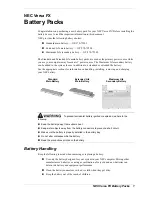
ENGLISH
GREAT BRITAIN
For consumer contact, please visit www.clasohlson.co.uk and click on customer service.
Ver. 200811
Battery Charger
Art.no.: 18-2442
Model: BC-2612T-UK
36-3633
BC-2612T
Please read the entire instruction manual before using the product
and save it for future reference. We apologise for any text or photo-
graphic errors and any changes of technical data. If you have any
questions concerning technical problems please contact our
Customer Service Department.
1. Safety
• This charger is only intended for the charging of rechargeable
lead-acid batteries. The charging of other types of battery could
damage the charger, battery or other property.
• Battery acid is corrosive. If any acid comes into contact with
your skin or eyes: Rinse immediately with plenty of water and
immediately contact a doctor.
• The charger is not intended for use as a power supply unit.
• Only use the battery charger indoors in a well ventilated place.
Do not cover the charger.
• Never expose the charger to moisture or humidity.
• During charging the battery can emit explosive gases. It is
therefore important to avoid making sparks close to the battery.
• Wear safety glasses and turn your face away when you connect
or disconnect the battery clamps.
• Always disconnect the charger from the power supply before
cleaning it or when it is not in use.
• Never use the charger if it is damaged. Do not charge
damaged batteries.
• Do not open the casing. Certain components inside the casing
carry dangerous currents. Contact with these may cause
electric shocks.
• The charger should only be repaired by qualified service personnel.
• The charger is only short-circuit protected for a limited duration;
avoid short-circuiting the charger for longer than 1 minute,
otherwise the charger could become damaged.
• Make sure the battery is connected with the correct polarity.
• Open the battery caps (does not apply to maintenance-free
batteries) before charging.
• Check the level of the electrolyte and top up with distilled water
if necessary before beginning to charge the battery.
• The battery charger and lead-acid batteries are not toys. Do not
let children use them without supervision.
• First unplug the charger from the mains, then remove the battery
clamps from the terminals.
2. Product Description
• Automatically charges 2, 6 and 12 V lead-acid batteries.
• Switches automatically to maintenance charge when the battery
is fully charged.
• Safety feature to ensure that the connectors are not live until
they are connected to the battery in the correct way.
• Protected from short circuits and reverse polarity.
N.B.
Make sure that the charger is set to the correct voltage
setting. Setting the charger incorrectly can result in damage to
the battery and/or charger.
3. Functions
• As opposed to a simpler charger, the charging current of this
charger is variable and depends on the battery’s level of charge,
condition, age, capacity and type.
• If the battery is very discharged, the charger will use a high
charging current (up to 0.6 A) at the beginning, after a while
the current will then drop whilst the voltage will increase. Large
batteries naturally take longer to charge than smaller batteries.
• The battery does not need to be completely discharged before
it is recharged; it is all right to charge a partially discharged
battery. The battery can also be connected to the charger for
maintenance charging over a long period of time.
• If the charger is short circuited or the polarity is reversed when
connected, the charger will be disconnected immediately.
It will start automatically when the cables have been properly
connected to the battery.
• The charger will make sure that the battery becomes fully
charged whilst at the same time preventing over-charging and
internal gas build-up.
• LEDs indicate charging (green) and reverse polarity or defect
battery (red).
4. Use
1. Always unplug the charger from the mains before connecting
the charger leads to the battery.
2. Before starting to charge the battery, make sure the battery is
rechargeable and has a rated voltage of 2, 6 or 12 V.
3. Set the selector switch (on the bottom of the charger) to the
correct voltage (2, 6 or 12 V) depending on the type of battery.
4. Connect the positive (RED) battery clamp to the battery’s
positive terminal (+) and the negative (BLACK) to the battery’s
negative terminal (-).
5. Plug the charger into the mains to start the charging process.
6. The LEDs on the front of the charger display the status of
the charging:
•
Red:
Defective battery, reversed polarity
•
Green:
The battery is correctly connected and charging
has commenced.
•
None of the LEDs come on:
The selector on the bottom of
the charger is set to the wrong voltage. Open-circuit in the
battery or leads. The battery clamps are not connected to
a battery.
5. Care and Maintenance
Always disconnect the charger from the power source before cleaning.
Use a soft, damp cloth to clean the device. Never clean the product
using strong detergents or solvents.
6. Troubleshooting
The charger does not start charging:
1. Check the terminal voltage of the battery.
2. Make sure that the selector on the bottom of the charger is set to
the same terminal voltage as the battery.
3. The battery might be faulty, test the charger with another battery.
7. Disposal
Follow local ordinances when disposing of this product.
If you are unsure how to dispose of the product, please
contact your municipality.
8. Specifications
Battery charger for
lead-acid batteries
having a voltage of:
2, 6 or 12 V.
Power supply:
230 V AC, 50 Hz (Max. 22 W)
Charging current:
Max. 0.6 A
Charging voltage:
Normal charging: 2.3 V, 6.9 V and 13.8 V
Maintenance charging:
Max. 100 mA
Recommended battery
capacity:
2 Ah – 10 Ah
Short-circuit protection:
Yes, for up to 1 minute






















